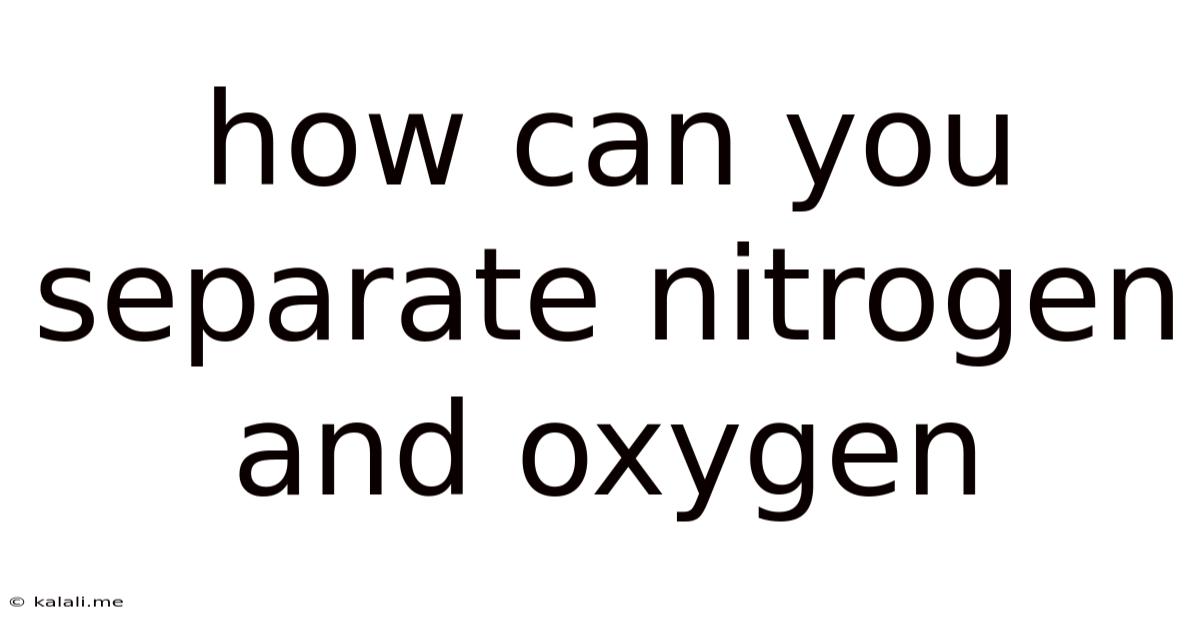How Can You Separate Nitrogen And Oxygen
Kalali
Jun 11, 2025 · 3 min read

Table of Contents
How Can You Separate Nitrogen and Oxygen? A Deep Dive into Gas Separation Techniques
Air, the lifeblood of our planet, is a mixture predominantly composed of nitrogen (approximately 78%) and oxygen (approximately 21%), along with trace amounts of other gases like argon, carbon dioxide, and neon. Separating these two major components, nitrogen and oxygen, is crucial for various industrial applications, from medical uses to manufacturing processes. But how is it done? This article explores the primary methods used to achieve this separation.
The key to separating nitrogen and oxygen lies in exploiting the subtle differences in their physical properties, primarily their boiling points. Oxygen has a slightly higher boiling point than nitrogen (-183°C vs -196°C). This seemingly small difference allows for effective separation using several techniques.
Fractional Distillation: The Workhorse of Industrial Separation
Fractional distillation is the most common and industrially significant method for separating nitrogen and oxygen. This process takes advantage of the different boiling points. Air is first compressed, cooled, and purified to remove contaminants like water vapor and carbon dioxide. This clean, compressed air is then cooled to a temperature below the boiling point of both nitrogen and oxygen, causing it to liquefy.
This liquefied air is then fed into a fractional distillation column. As the liquefied air rises through the column, its temperature gradually decreases. Nitrogen, with its lower boiling point, vaporizes first and is collected at the top of the column. Oxygen, with its higher boiling point, remains in the liquid phase longer and is collected lower down in the column. The purity of the separated gases can be further enhanced through multiple distillation stages. This method is highly efficient and produces large quantities of high-purity nitrogen and oxygen.
Other Separation Methods: Exploring Alternatives
While fractional distillation reigns supreme in industrial applications, other methods exist, each with its own niche:
-
Membrane Separation: This technique utilizes selectively permeable membranes that allow nitrogen to pass through more readily than oxygen. Compressed air is fed into a membrane module, and nitrogen preferentially diffuses through the membrane, leaving a stream enriched in oxygen behind. Membrane separation is particularly useful for smaller-scale applications and producing nitrogen with slightly lower purity than fractional distillation. This method is also more energy-efficient for smaller-scale production.
-
Pressure Swing Adsorption (PSA): PSA systems use specialized adsorbent materials that selectively adsorb oxygen, leaving a nitrogen-rich stream. The process involves cycles of pressurization and depressurization to alternately adsorb and desorb oxygen. PSA is another popular method for producing nitrogen, particularly in on-site generation applications where a continuous supply of nitrogen is needed. This method allows for flexible and localized nitrogen production.
-
Cryogenic Air Separation Units (CASU): These units combine several techniques, including compression, cooling, and expansion, to efficiently separate nitrogen and oxygen. Cryogenic air separation is largely an improved, more efficient variant of the fractional distillation method. The use of advanced cryogenic techniques improves the yield and efficiency.
Conclusion: Choosing the Right Method
The optimal method for separating nitrogen and oxygen depends heavily on several factors, including the required purity, scale of production, and overall cost considerations. Fractional distillation remains the dominant technology for large-scale production of high-purity gases. However, membrane separation and PSA offer viable alternatives for smaller-scale operations and situations demanding on-site nitrogen generation. Each method offers a unique balance of efficiency, cost, and purity, enabling diverse applications across various industries.
Latest Posts
Latest Posts
-
How Many Cups Are In 29 Oz
Jul 01, 2025
-
How Many Fluid Ounces In A Half Gallon
Jul 01, 2025
-
How Many Chicken Thighs In A Pound
Jul 01, 2025
-
How Old Is Someone Born In 1992
Jul 01, 2025
-
How Many Grams Is In A Pint
Jul 01, 2025
Related Post
Thank you for visiting our website which covers about How Can You Separate Nitrogen And Oxygen . We hope the information provided has been useful to you. Feel free to contact us if you have any questions or need further assistance. See you next time and don't miss to bookmark.